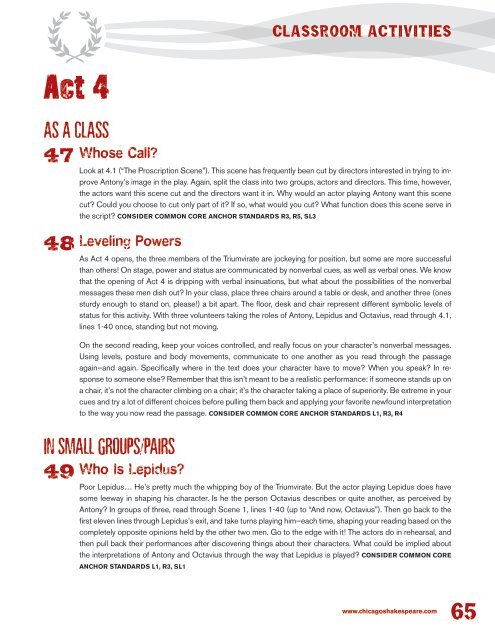Julius Caesar • 2013 - Chicago Shakespeare Theater
Julius Caesar • 2013 - Chicago Shakespeare Theater
Julius Caesar • 2013 - Chicago Shakespeare Theater
Create successful ePaper yourself
Turn your PDF publications into a flip-book with our unique Google optimized e-Paper software.
Act 4<br />
AS A CLASS<br />
47<br />
48<br />
Whose Call?<br />
CLASSROOM ACTIVITIES<br />
Look at 4.1 (“The Proscription Scene”). This scene has frequently been cut by directors interested in trying to improve<br />
Antony’s image in the play. Again, split the class into two groups, actors and directors. This time, however,<br />
the actors want this scene cut and the directors want it in. Why would an actor playing Antony want this scene<br />
cut? Could you choose to cut only part of it? If so, what would you cut? What function does this scene serve in<br />
the script? CONSIDER COMMON CORE ANCHOR STANDARDS R3, R5, SL3<br />
Leveling Powers<br />
As Act 4 opens, the three members of the Triumvirate are jockeying for position, but some are more successful<br />
than others! On stage, power and status are communicated by nonverbal cues, as well as verbal ones. We know<br />
that the opening of Act 4 is dripping with verbal insinuations, but what about the possibilities of the nonverbal<br />
messages these men dish out? In your class, place three chairs around a table or desk, and another three (ones<br />
sturdy enough to stand on, please!) a bit apart. The floor, desk and chair represent different symbolic levels of<br />
status for this activity. With three volunteers taking the roles of Antony, Lepidus and Octavius, read through 4.1,<br />
lines 1-40 once, standing but not moving.<br />
On the second reading, keep your voices controlled, and really focus on your character’s nonverbal messages.<br />
Using levels, posture and body movements, communicate to one another as you read through the passage<br />
again—and again. Specifically where in the text does your character have to move? When you speak? In response<br />
to someone else? Remember that this isn’t meant to be a realistic performance: if someone stands up on<br />
a chair, it’s not the character climbing on a chair; it’s the character taking a place of superiority. Be extreme in your<br />
cues and try a lot of different choices before pulling them back and applying your favorite newfound interpretation<br />
to the way you now read the passage. CONSIDER COMMON CORE ANCHOR STANDARDS L1, R3, R4<br />
IN SMALL GROUPS/PAIRS<br />
49<br />
Who Is Lepidus?<br />
Poor Lepidus… He’s pretty much the whipping boy of the Triumvirate. But the actor playing Lepidus does have<br />
some leeway in shaping his character. Is he the person Octavius describes or quite another, as perceived by<br />
Antony? In groups of three, read through Scene 1, lines 1-40 (up to “And now, Octavius”). Then go back to the<br />
first eleven lines through Lepidus’s exit, and take turns playing him—each time, shaping your reading based on the<br />
completely opposite opinions held by the other two men. Go to the edge with it! The actors do in rehearsal, and<br />
then pull back their performances after discovering things about their characters. What could be implied about<br />
the interpretations of Antony and Octavius through the way that Lepidus is played? CONSIDER COMMON CORE<br />
ANCHOR STANDARDS L1, R3, SL1<br />
www chicagoshakespeare com 65




